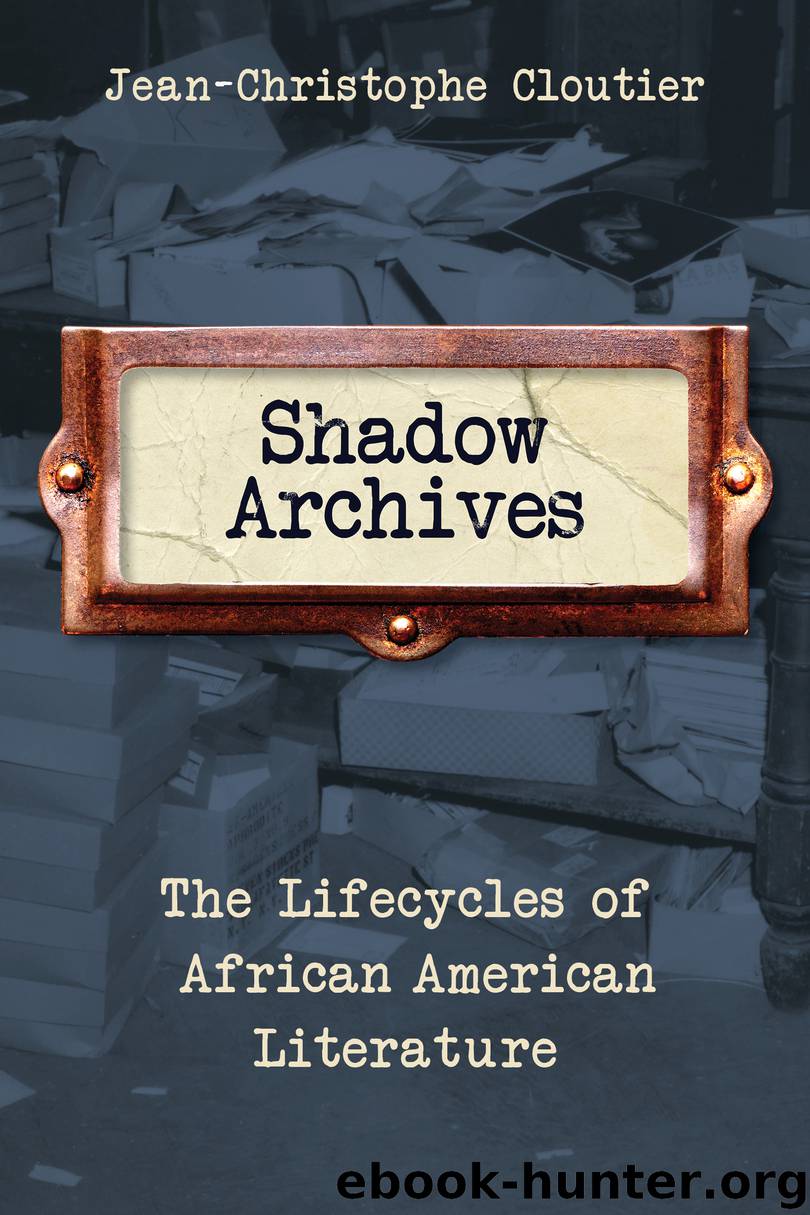Shadow Archives by Jean-Christophe Cloutier

Author:Jean-Christophe Cloutier
Language: eng
Format: epub
Publisher: Columbia University Press
FIGURE 3.8. Detail from contact sheet, untitled, Harlem, New York, 1948; image for caption H, “Harlem Is Nowhere” project. Photograph by Gordon Parks.
Source: Courtesy of and copyright © The Gordon Parks Foundation.
Remarkably, the excavation and reconstitution of the original “Harlem Is Nowhere” photo-text demonstrate that what originated as chiefly a photographic directive—to have “scenes that are at once both document and symbol”—ultimately became the guiding principle behind Ellison’s crafting of his novel Invisible Man, to the extent that looking at the shooting script today feels like finding the Peter Wheatstraw blueprints Ellison followed as a novelist. That poignant phrase from caption H, “the unseen eye is watching you,” ultimately became the disembodied narrative voice that, equally unseen, “speaks for you” from the lower frequencies at the end of Invisible Man. That unseen voice flips the “watching” by state surveillance on its head to become a benevolent “watching over,” marking an important transfer of agency and power, just as this photograph rises as yet another origin for Ellison’s trope of invisibility. Equally fascinating is the realization occasioned by these materials of the extent to which Ellison’s collaboration with Parks forged his novelistic vision. Parks’s strategies for solving the problem of creating pictures that were simultaneously document and symbol gave Ellison a visual model for his own aesthetic project. In turn, for Parks, this collaboration with Ellison, as historian Erika Doss has observed, “was instrumental in terms of shaping Parks’ postwar understanding of race and representation.”152
Their initial collaboration had gone so well, in fact, that Parks attempted to enlist Ellison in his initial work at Life shortly after the “Harlem Is Nowhere” project was completed. “It was a project with Ellison that gave [Parks] confidence to approach the notoriously gruff Life picture editor Wilson Hicks in 1948,” photo historian Maren Stange has suggested. Parks confirmed this enlistment in an interview: “I had copies of the photographs and took them over to Life.”153 In other words, the portfolio Hicks consulted when Parks applied for a staff job at Life included the images intended for “Harlem Is Nowhere.” What all previous narratives of Parks’s entry at Life have elided, however, is that Parks initially wanted to continue collaborating with Ellison for the “Harlem Gang Leader” assignment. On August 13, 1948, Ellison wrote to a friend that he had just “had some talks with Life concerning a photo-essay assignment with Gordon Parks in which I am not interested and against which Fanny is dead set, although, God knows, we do need the dough.”154 Given the date of the letter, the assignment referred to could only be what became Parks’s first byline at Life, “Harlem Gang Leader,” published in the November 1, 1948, issue. We know that Ellison was ultimately not involved with “Gang Leader,” but this evidence does bring “Harlem Is Nowhere” and “Harlem Gang Leader,” whose contact sheets are intertwined, even closer and further helps explain how “Gang Leader” “inherited” the photograph Harlem Rooftops as its opening spread, thus granting it a new lifecycle.
Download
This site does not store any files on its server. We only index and link to content provided by other sites. Please contact the content providers to delete copyright contents if any and email us, we'll remove relevant links or contents immediately.
| African | Asian |
| Australian & Oceanian | Canadian |
| Caribbean & Latin American | European |
| Jewish | Middle Eastern |
| Russian | United States |
4 3 2 1: A Novel by Paul Auster(11027)
The handmaid's tale by Margaret Atwood(6834)
Giovanni's Room by James Baldwin(5868)
Big Magic: Creative Living Beyond Fear by Elizabeth Gilbert(4713)
Asking the Right Questions: A Guide to Critical Thinking by M. Neil Browne & Stuart M. Keeley(4558)
On Writing A Memoir of the Craft by Stephen King(4203)
Ego Is the Enemy by Ryan Holiday(3978)
Ken Follett - World without end by Ken Follett(3967)
The Body: A Guide for Occupants by Bill Bryson(3787)
Bluets by Maggie Nelson(3703)
Adulting by Kelly Williams Brown(3662)
Guilty Pleasures by Laurell K Hamilton(3577)
Eat That Frog! by Brian Tracy(3502)
White Noise - A Novel by Don DeLillo(3428)
The Poetry of Pablo Neruda by Pablo Neruda(3357)
Alive: The Story of the Andes Survivors by Piers Paul Read(3300)
The Bookshop by Penelope Fitzgerald(3220)
The Book of Joy by Dalai Lama(3211)
Fingerprints of the Gods by Graham Hancock(3205)
